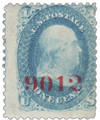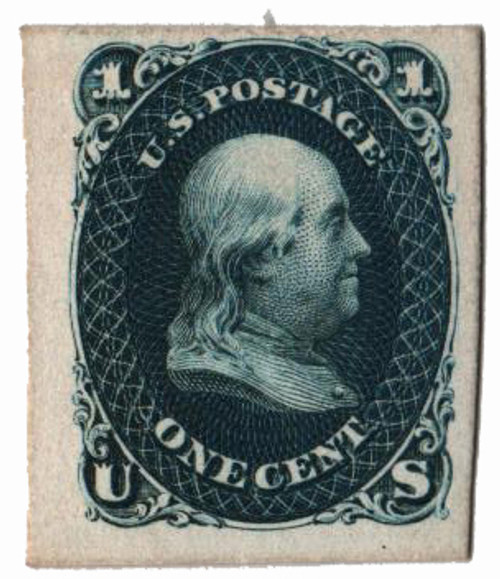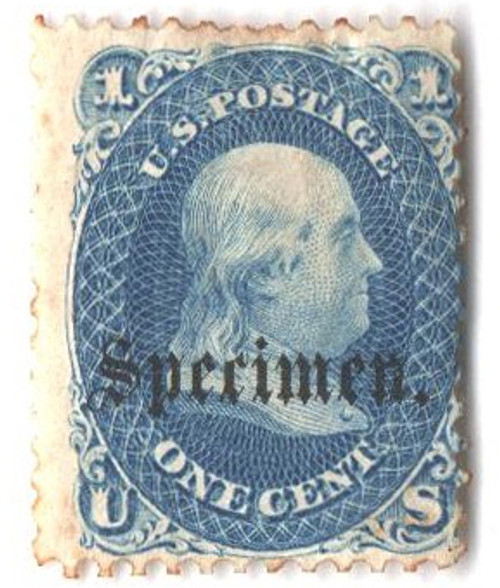
# 63SJ - 1861 1c Blue Specimen with Control Number 9012 in Carmine
Scarcely-Seen Specimen Can Be Yours – Only 100 Examples Known!
Specimen stamps are an often-overlooked area of philately. They were produced and distributed primarily to serve as samples for local and foreign postal authorities. Having reference collections allowed clerks to distinguish valid postage from counterfeits, which encouraged the exchange of international mail by discouraging fraud.
Specimen stamps were created by adding overprints to regular stamps to render them invalid for postage. They were produced in very limited quantities, in fact, this particular specimen has only 100 known to exist.
The stamp you'll receive when you order today will be in very good condition with original gum (with slight hinge remnant).
U.S. #63
The earliest-known use of the 1861 1¢ Blue Franklin was August 17, 1861. Approximately 138,000,000 of the stamps were printed by the National Bank Note Company by flat plate and perforated 12.
In 1860 and 1861, 11 Southern states left the Union and formed the Confederate States of America, an action that resulted in the beginning of the Civil War. On April 12, 1861, the war erupted at Fort Sumter. Less than two months later, the United States discontinued postal services to the South. However, numerous stamps were still in the hands of postmasters of seceding states.
Fearing these stamps would be sent to the North and sold (thus providing money to the Confederate states), the United States sent a proclamation to all postmasters, requesting that the remainders be sent to Washington. When this order was largely ignored, the government made arrangements for designing new issues and demonetizing the old issues.
The process of demonetizing rendered the old stamps invalid, while at the same time replacing them with the newly designed stamps. The new 1861 stamps were sent to post offices along with a notice that required an exchange period of six days be announced in local newspapers. During the exchange period, old stamps could be exchanged for new ones. After the six-day exchange period, the old stamps were no longer accepted as postage.
While the designs and color of the new issues differed from the old ones, the Postal Service wanted to be certain there would be no confusion between the two. They felt a change that could be easily recognized was necessary, and so thte 1861 issues have the values expressed in numerals instead of being written out.
Scarcely-Seen Specimen Can Be Yours – Only 100 Examples Known!
Specimen stamps are an often-overlooked area of philately. They were produced and distributed primarily to serve as samples for local and foreign postal authorities. Having reference collections allowed clerks to distinguish valid postage from counterfeits, which encouraged the exchange of international mail by discouraging fraud.
Specimen stamps were created by adding overprints to regular stamps to render them invalid for postage. They were produced in very limited quantities, in fact, this particular specimen has only 100 known to exist.
The stamp you'll receive when you order today will be in very good condition with original gum (with slight hinge remnant).
U.S. #63
The earliest-known use of the 1861 1¢ Blue Franklin was August 17, 1861. Approximately 138,000,000 of the stamps were printed by the National Bank Note Company by flat plate and perforated 12.
In 1860 and 1861, 11 Southern states left the Union and formed the Confederate States of America, an action that resulted in the beginning of the Civil War. On April 12, 1861, the war erupted at Fort Sumter. Less than two months later, the United States discontinued postal services to the South. However, numerous stamps were still in the hands of postmasters of seceding states.
Fearing these stamps would be sent to the North and sold (thus providing money to the Confederate states), the United States sent a proclamation to all postmasters, requesting that the remainders be sent to Washington. When this order was largely ignored, the government made arrangements for designing new issues and demonetizing the old issues.
The process of demonetizing rendered the old stamps invalid, while at the same time replacing them with the newly designed stamps. The new 1861 stamps were sent to post offices along with a notice that required an exchange period of six days be announced in local newspapers. During the exchange period, old stamps could be exchanged for new ones. After the six-day exchange period, the old stamps were no longer accepted as postage.
While the designs and color of the new issues differed from the old ones, the Postal Service wanted to be certain there would be no confusion between the two. They felt a change that could be easily recognized was necessary, and so thte 1861 issues have the values expressed in numerals instead of being written out.











